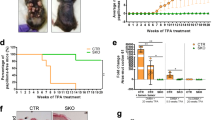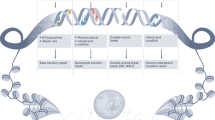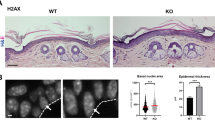Abstract
SINCE the discovery that cells from patients with xeroderma pigmentosum, a disease associated with a high incidence of cancer, may be unable to excise ultraviolet light-induced thymine dimers from DNA1, and the recognition of the possibility that all carcinogens react with the DNA of the organs in which tumours are induced2, it has been thought that repair of changes produced in DNA by carcinogens might be important in moderating the effectiveness of these compounds. Work on the carcinogenic effect of prolonged administration of various chemicals3, however, suggests that individual carcinogenic doses are entirely cumulative in their action, and that the carcinogenic damage is permanent and not repaired4. If this were correct, repair of lesions produced in DNA by carcinogens would seem to have no direct relevance to carcinogenesis. Recovery from the lethal effects of radiation was established by the classic experiments of Elkind and Sutton5 in which cultured cells were irradiated twice with different intervals between the first and second dose; if sufficient time elapsed between the first and second dose, the effects of the doses were not cumulative. We have used an analogous experimental design to study the cumulation of the effect of dimethylnitrosamine in the induction of kidney tumours in the rat. The experiment is not yet complete, but we believe we have demonstrated that a repair process exists.
This is a preview of subscription content, access via your institution
Access options
Subscribe to this journal
Receive 51 print issues and online access
$199.00 per year
only $3.90 per issue
Buy this article
- Purchase on Springer Link
- Instant access to full article PDF
Prices may be subject to local taxes which are calculated during checkout
Similar content being viewed by others
References
Cleaver, J. E., Proc. natn. Acad. Sci. U.S.A., 63, 428–435 (1969).
Miller, J. A., Cancer Res., 30, 559–576 (1970).
Druckrey, H., in Potential Carcinogenic Hazards from Drugs (edit. by Truhaut, R.), 60–78 (Springer, Berlin, 1967).
Nakahara, W., in Hdb. allgemeinen Pathologie, 6 (2) (edit. by Grundmann, E.), 595–650 (Springer, Berlin, 1975).
Elkind, M. M., and Sutton, H., Radiat. Res., 13, 556–593 (1960).
Swann, P. F., and McLean, A. E. M., Biochem. J., 124, 283–288 (1971).
Hard, G. C., and Butler, W. H., Cancer Res., 30, 2806–2815 (1970).
Margison, G. P., Capps, M. J., O'Connor, P. J., and Craig, A. W., Chem-Biol. Interact., 6, 119–124 (1973).
Lawley, P. D., Mutat. Res., 23, 283–295 (1974).
Goth, R., and Rajewsky, M. F., Proc. natn. Acad. Sci. U.S.A., 71, 639–643 (1974).
Kleihues, P., and Margison, G. P., J. natn. Cancer Inst., 53, 1839–1841 (1974).
Nicoll, J. W., Swann, P. F., and Pegg, A. E., Nature, 254, 261–262 (1975).
Margison, G. P., and Kleihues, P., Biochem. J., 148, 521–525 (1975).
Kleihues, P., and Margison, G. P., Nature, 259, 153–155 (1976).
Author information
Authors and Affiliations
Rights and permissions
About this article
Cite this article
SWANN, P., MAGEE, P., MOHR, U. et al. Possible repair of carcinogenic damage caused by dimethylnitrosamine in rat kidney. Nature 263, 134–136 (1976). https://doi.org/10.1038/263134a0
Received:
Accepted:
Issue Date:
DOI: https://doi.org/10.1038/263134a0
This article is cited by
-
The problem of thresholds in chemical carcinogenesis some views on theoretical and practical aspects
Journal of Cancer Research and Clinical Oncology (1980)
Comments
By submitting a comment you agree to abide by our Terms and Community Guidelines. If you find something abusive or that does not comply with our terms or guidelines please flag it as inappropriate.



